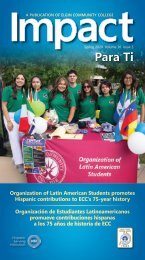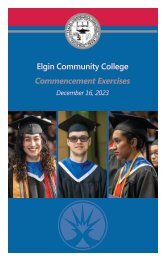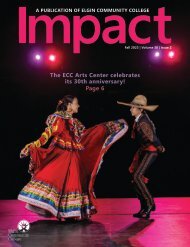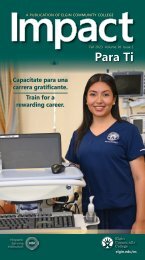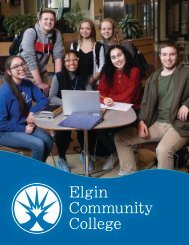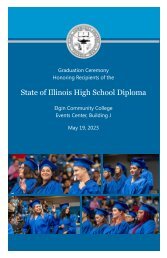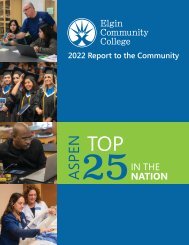ILEA Equity Plan | Elgin Community College (ECC)
There are wide and persistent gaps in college completion rates in Illinois, especially among students of color and low-income students. After an in-depth analysis of our institutional data, Elgin Community College (“ECC” or “the College” or “we” or “our”) has developed an Equity Plan containing annual growth targets for which progress updates will be shared publicly over the next five years. Our Equity Plan reflects the unique characteristics of our institution. For example, ECC is designated as a Hispanic Serving Institution by the US Department of Education, with just over 42% of the students identifying as Latinx or Hispanic. Also, the district served by ECC is widely diverse in terms of income and educational attainment. We will identify the obstacles students face and develop programs and policies that break down unnecessary college graduation barriers. Along with our fellow colleges, in the Partnership for College Completion organization, with this Illinois Equity in Attainment (“ILEA”) plan, we pledge to close the completion gaps by 2025.
There are wide and persistent gaps in college completion rates in Illinois, especially among students of color and low-income students. After an in-depth analysis of our institutional data, Elgin Community College (“ECC” or “the College” or “we” or “our”) has developed an Equity Plan containing annual growth targets for which progress updates will be shared publicly over the next five years. Our Equity Plan reflects the unique characteristics of our institution. For example, ECC is designated as a Hispanic Serving Institution by the US Department of Education, with just over 42% of the students identifying as Latinx or Hispanic. Also, the district served by ECC is widely diverse in terms of income and educational attainment. We will identify the obstacles students face and develop programs and policies that break down unnecessary college graduation barriers. Along with our fellow colleges, in the Partnership for College Completion organization, with this Illinois Equity in Attainment (“ILEA”) plan, we pledge to close the completion gaps by 2025.
You also want an ePaper? Increase the reach of your titles
YUMPU automatically turns print PDFs into web optimized ePapers that Google loves.
To assess the first pilot group of MAP students from Spring 2019, a comparison group was<br />
created with students who fell just outside the credit boundaries. These two groups were<br />
similar in gender, race/ethnicity, age, and academic success. Retention rates and advising<br />
appointments were higher among the MAP group than the comparison group.<br />
Table 11. Map Pilot Retention Results<br />
MAP<br />
Group<br />
Comparison<br />
Group<br />
Spring 2019 students enrolled in Fall 2019 80% 67%<br />
Latinx students 84% 71%<br />
Black/African American 70% 38%<br />
As Table 11 displays, the MAP students enrolled in Fall 2019 at a rate of 80% compared to 67%<br />
for the comparison group. This retention rate increase can be seen within minority student<br />
groups as well. Latinx students enrolled 13 percentage points higher and Black/African-<br />
American students saw a 32 percentage point increase.<br />
As part of the <strong>ILEA</strong> <strong>Equity</strong> <strong>Plan</strong>, mandatory advising will be continued. The strategy is<br />
connected to other institutional efforts and supports <strong>ECC</strong>’s strategies in our 2018-2022<br />
Strategic <strong>Plan</strong>. See Table 9 for specific strategies that are aligned.<br />
The Success Indicators used to demonstrate this strategy is having an impact are:<br />
• Student completion of course and programs<br />
• Student progression through their pathway<br />
• Transfer to subsequent educational<br />
• Student engagement and satisfaction with college programs and services<br />
• Student mastery of learning outcomes<br />
• Enrollment of identified target populations<br />
• Degree of fit between students’ goals, skills, and experiences and college programs and<br />
services<br />
• Readiness of incoming students<br />
• Preparedness of graduates for transfer and/or employment<br />
<strong>ILEA</strong> EQUITY PLAN STRATEGY 2: OER – OPEN EDUCATIONAL RESOURCES<br />
Open Educational Resources (“OER”) are high quality educational content/materials that are<br />
free to students. OER is a growing movement in higher education. It is broadly defined as “the<br />
open provision of educational resources, enabled by information and communication<br />
technologies, for consultation, use, and adaptation by a community of users for noncommercial<br />
purposes” (UNESCO, 2002, p. 24). At <strong>ECC</strong>, OER will “encompass free, online learning content,<br />
software tools, and accumulated digital curricula that are not restricted by copyright license<br />
and available to retain, reuse, revise, remix, and redistribute” (Hilton, Fischer, Wiley, &<br />
Williams, 2016). By removing the cost of these materials access to higher education will<br />
improve, costs will be reduced, student performance will be improved and more students will<br />
complete in less time and with less debt.<br />
33<br />
<strong>ILEA</strong> <strong>Equity</strong> <strong>Plan</strong><br />
Institutional Strategies







